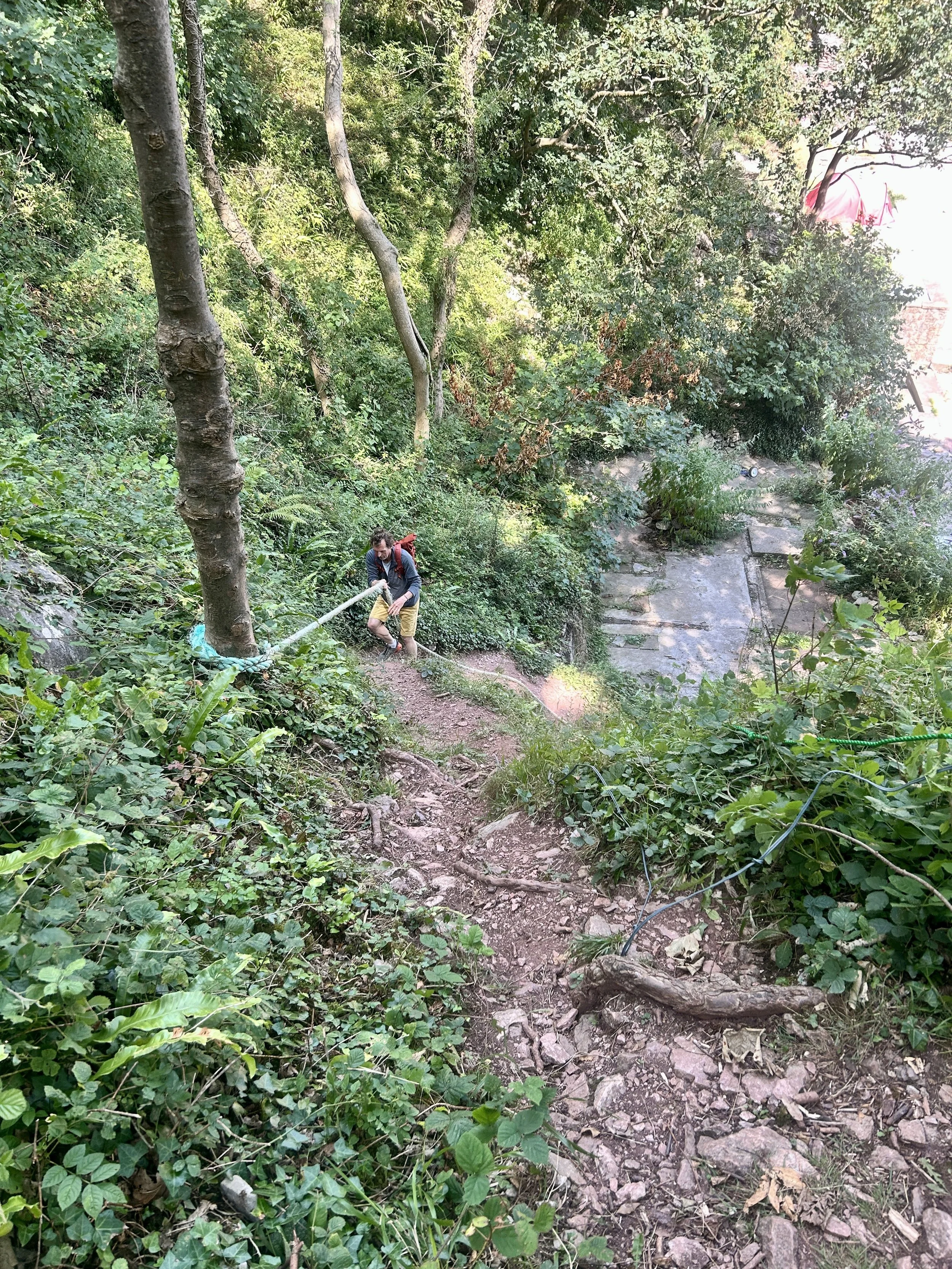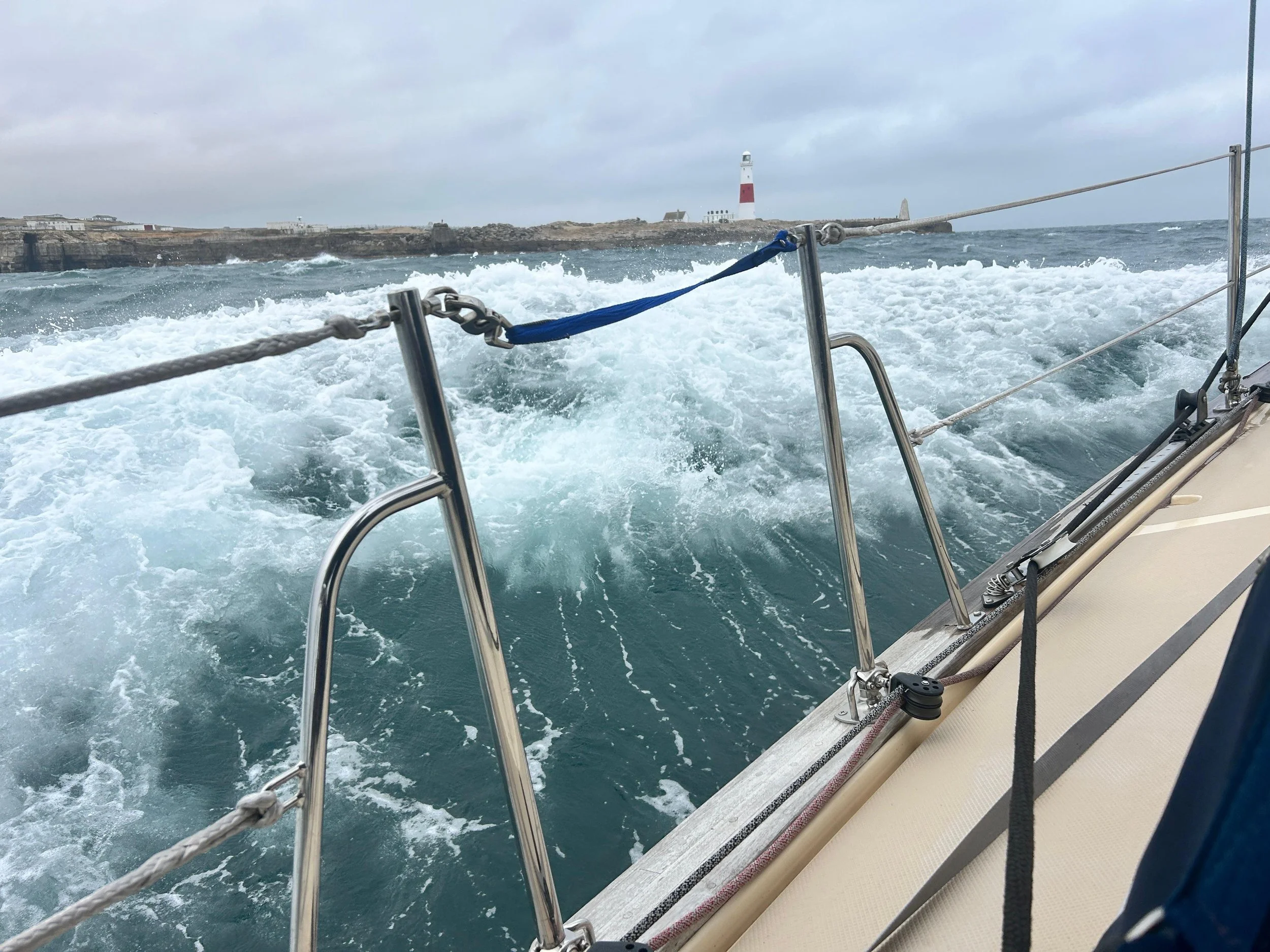WEEK 5
Monday 4th August
Storm Floris arrived in the UK today. Initially forecast to hit the south of England, she moved northwards towards Scotland. In preparation for a good blow, we stayed on the mooring buoy rather than dropping anchor. In the end, the wind wasn’t too bad, but it rained all day until 1700hrs.
We stayed comfortably on board, sorting out the problems of the world to the sound of rain bouncing off the coach roof.
When the rain finally stopped, we had an urge for fish and chips. The tender took us the 2nm downstream to Dartmouth, where we picked up supplies for the next couple of days before heading to the Floating Bridge Inn for an excellent fish and chip dinner.
Tuesday 5th August
We woke to strong northerly winds blustering across the anchorage. The sky was blue and filled with hundreds of squawking seagulls that had taken shelter inland.
Mid-morning I dropped Able Seaman Lucy a kilometre upstream so she could swim back on the turning tide. Although I rowed briskly back to the boat, she arrived only a minute later—she has always been quick in the water, though it looked very chilly to me.
Lunch was cheese and tomato sandwiches dipped in chicken, butternut squash and lentil soup—likely to become a hot favourite from now on. At 1330hrs we dropped the buoy and headed down stream to Dartmouth to fill up with water and diesel. An hour later we were under sail in 15–20kts true wind, heading around Berry Head and across Tor Bay to anchor at Anstey’s Cove.
As usual, no reef in, but unusually I didn’t deploy the staysail. We were into wind and making good progress over a flat sea, though the weather helm was quite extreme at times and Able Seaman Lucy had to fight to stay on course. Weather helm on EIVIVA always comes back! Good fun.
Anstey’s Cove is small but well protected from most wind angles except the east. A few boats were already at anchor—a good sign. We dropped the hook, backed off to make sure we were set, and settled in for the night.
Wednesday 6th August
Before breakfast, Lucy swam from the boat to the rocks lining the north edge of the cove and back. It was further than it looked and much colder than the River Dart. She spent an hour shivering in my cold weather watch coat before the sun warmed her up.
Mid-morning we took the tender ashore and climbed up to the coastal path towards Babbacombe Beach and the Cliff Railway. The steep climb from sea level was so sharp in places that ropes had been tied to trees to help with the ascent. I was out of breath at the top; Lucy seemed unaffected.
Babbacombe clearly had its heyday in the 1920s, when the funicular railway was built, leading to a high-level promenade lined with “Fawlty Towers” hotels. The beach had low 1930s-style concrete pavilions, and the sand was packed with wriggling, semi-naked, sunburned humanity. We had a cheeseburger of dubious flavour—possibly mildly seasoned cardboard—and then took the cliff railway back up before walking along the coastal path to Anstey’s Cove.
We decided to visit the other half of the beach where a small café tempted us with clotted cream ice cream. A steep track led down easily, but our plan to walk along the base of the cliff back to the tender was foiled by the tide. So it was back up and down the hard route again.
Chicken stew and an early night on board, ready to cross Lyme Bay to Portland Bill tomorrow with 14-20kts of forecast south-westerlies.
Leaving the beach.
Returning in the evening.
The Babbacombe Cliff Railway.
There was only one inhabitant of Anstey’s cove…….
Thursday 7th August
This morning the smell of bacon from the café proved irresistible and we indulged in a full English breakfast. At 1030hrs we raised the anchor and set sail in 14kts of wind from 120 degrees to starboard, bound for Portland Bill and Weymouth where Lucy would catch her train tomorrow.
We planned the first part of the passage against the tide so that we’d round Portland Bill with the east-going stream. The wind soon picked up to 20kts and we made such good progress that we arrived just past slack water. After triple-checking the navigation advice for the inner passage, I decided we could make it. The tides were a few days after neaps, timing was within the two-hour window, and both wind and tide were in our favour—though the wind was still around 20kts with a moderate following sea.
As we approached, the sea bunched up over the underwater ledge, the depth rising from 80m to 20m. Waves became chaotic where three tidal streams met, and, naturally, the wind picked this moment to blow 25kts with the full rig still flying. EIVIVA must have been a fine sight for the few hardy souls ashore as we shot past at 10.5kts, corkscrewing down the whitecaps. Ten adrenaline-filled minutes later, we were out into flat water—not for the faint-hearted.
Lucy then took the helm and kept ahead of a Hallberg-Rassy 46 as we sailed down the east side of the Bill at 8.5kts into Portland Harbour, where we dropped the hook. A proper sailing adventure.
Portland inshore passage.
Friday 8th August
Lucy’s train to Glasgow was at 0930. We left Portland Harbour just after 0700 and anchored off the beach near the harbour entrance half an hour later. After a quick tender trip to the town quay, Lucy departed, and I made a dash to Tesco, carefully avoiding the harbour office CCTV—they have quite a reputation in Weymouth.
At 1100 I left with the intention of stopping in Swanage Bay. The tide was against us for six hours, but a steady 12kts of wind and flat seas made for pleasant spinnaker sailing at 6kts. On arrival at Swanage, conditions were so good I decided to press on for Chichester Harbour. The tide would turn in our favour and the wind was forecast to freshen slightly.
The sun was going down as we passed St Catherine’s Point so I dropped the kite, then gybed towards Chichester Harbour continuing under white sails. The full moon made navigation into Chichester simple. Seeing another boat on my mooring, I anchored in the adjacent bay.
A very relaxing final day at sea for the 2025 (B)log.
This year’s sailing was shorter than usual due to the engine swap, and the wind was often uncooperative—particularly the highly unusual north-westerlies during my Isles of Scilly week. I sailed mostly familiar waters, never boring but with few new places to visit. Next year I fancy Denmark and Sweden, both new to me.
We shall see.
Packing the spinnaker at dusk. Not that you can see it.









